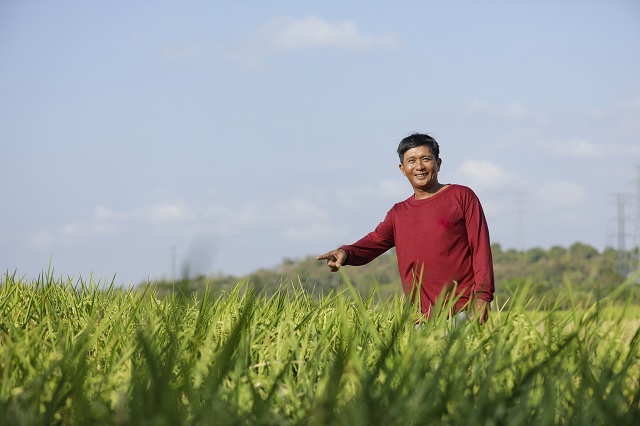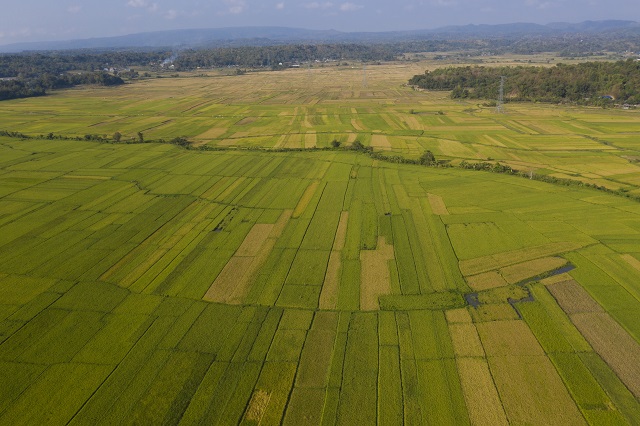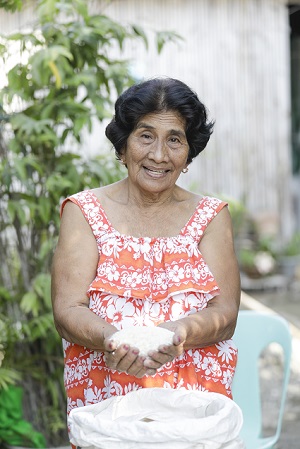
When rice farmers ‘cried’ at the unacceptable palay prices in 2019, Ronald Aceret of Bacarra, Ilocos Norte ‘shed tears’ with them. He figured it wasn’t the best season in his long-lived farming career.
“The price was low, and so was my harvest. Deduct the fertilizers, pesticides, labor, and other farm expenses, there was almost nothing left for me to count. I was just grateful and consoled that we still had rice on our table,” the 43-year-old farmer recalls.
On the other side of his fence, there was farming hobbyist Lourdes Ibañez who was silently saddened by her fellow farmer’s predicament. The 83-year-old grandmother was somehow relieved that she has children to support her farm activities and that she processes her produce before selling it.
“Some of my children provide for my fertilizer needs, so I still have something for my other farm inputs. In exchange, I give them and their families two sacks of milled rice each time I harvest,” she opens up.
Ronald and Lourdes continued farming despite their struggles. It was their identity, not just their bread and butter, like the remaining residents of Bacarra whose main source of livelihood is farming, rice as their main crop.
They could only pray for intervention.
Answered prayer

Behind their groans, PhilRice and their local government unit were already collaborating for the maiden implementation of the Rice Competitiveness Enhancement Fund (RCEF) – Seed Program. It aims to provide free certified inbred rice seeds to qualified farmers to help them increase their yield and cut on cost for a bonus.
The Bacarra Municipal Agriculture Office facilitated the farmers’ enlistment to the Registry System for Basic Sectors in Agriculture, a masterlist of farmers who are qualified to benefit from the intervention.
They also liaised with the presidents of every farmers’ association in the target areas. One of them was Zanjera Camanggaan, an irrigators’ association composed of Bacarra farmers, including Ronald and Lourdes.
“Our president, Ferdinand Butac, was quick to relay the information to us so we did not delay,” Lola Lourdes is eager.
Unlike her and Ronald, the other members of the group did not respond positively. Ferdinand noted that some did not bother because they found the process tedious. He did not push these members further. At least he got 10 people who were willing to be supported.
It did not take long for the interested members to spread the most-awaited good news.
On November 9, 2019, Lourdes, Ronald, and their fellow Zanjera associates went to the old gasoline station in the nearby barangay where the RCEF seed distribution was positioned. Though they had to wait for a few hours to get their allocation, they were not disappointed at the end of that day.
Reaping fruits

On March 9, 2020 exactly four months later, Lourdes was all smiles when a tricycle carrying sacks of freshly milled rice maneuvered through her gate.
She pulled one sack, untied it, and scooped a handful of grains. They were still warm and probably vibrating on her fingertips.
“It just came out from the milling machine!” the grand lady announces.
Not too long ago, she was only pulling two bags of certified seeds of NSIC Rc 358, which she acquired from the seed distribution. Now, she is looking at the fruits of those seeds, which she diligently planted in her one-hectare rice area.
In a few hours, she will cook some of it and will treat herself to a rich meal.
“This is the first batch of my produce. I already harvested 55 sacks from the half-hectare portion of my farm. I think I can double that, even higher, when the harvesting is finally completed,” Lourdes crosses her fingers.
She could now imagine pocketing and bringing home a considerable income as soon as she sells her milled rice.
“The grains look good. I can sell this as milled rice at P2,000 per cavan,” she is optimistic.
Joining her, Ronald was also celebrating not just for Lola Lourdes but also for himself. It was his first time in several years to harvest more than 65 sacks of palay in his half hectare. He believed it was because of the RCEF seeds he received. Before, he could only harvest 45 sacks. Ronald contented himself with either replanting his own produce or exchanging seeds with other farmers.
“RCEF gave me a free bag of certified Rc 222 seeds. During the [technical] briefing, I learned the importance of proper land leveling and growing of rice seedlings before planting. Although there was a lot of work as I followed the recommendations, I realized it was worth it because I achieved good results,” he beams.
Ronald was also gratified because the free seeds allowed him to save more money. He decided to use the savings to buy other farm inputs like fertilizer.
He remembered having been a participant in the Plant-Now-Pay-Later Program of the DA.
“I was glad because I benefitted from that project. But the RCEF support was way better because I didn’t have to pay later,” Ronald compares.
Better days
William Ulep, the municipal agriculturist, believes that most of the RCEF-Seed Program beneficiaries in Bacarra are motivated like Lourdes and Ronald.
He said the program supplemented their local seed requirements. There were 1,241 farmers cultivating a total land area of 1,202.5ha who were blessed by RCEF. William hopes that more farmers will receive high-quality seeds for free in the coming seasons. He also found the program’s process systematic. He even thinks of adopting it in their similarly situated programs.
Meanwhile, Lourdes was still marveling at her freshly milled grains. When she raised her head, she wore a photogenic smile.
“Thank you for helping us. Thank you for giving it free and on time. Thank you for showing that you still care for us,” Lola Lourdes could not conceal her gratitude.
Don’t mention
it grandma!




